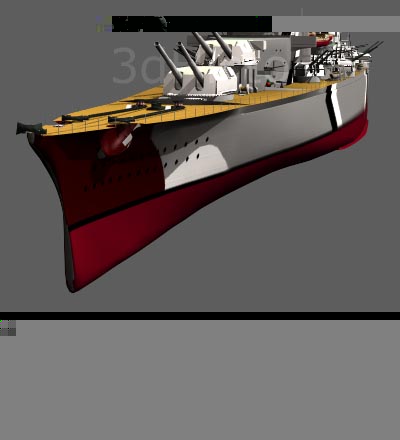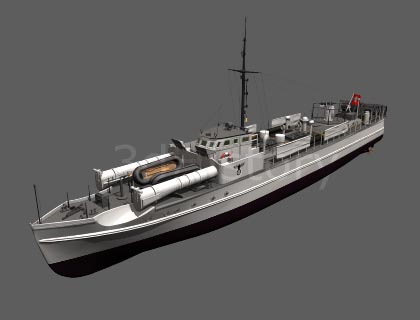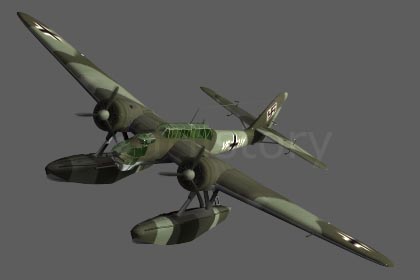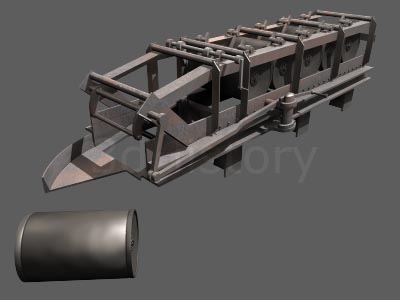The Second World War - North Atlantic - World War Two - War Machines
North Atlantic
The Battle of the Atlantic was a series of campaigns between 1939 and 1945, in which the Allied naval and air forces were challenged with protecting merchant convoys against German surface raiders, submarines and aircraft. Bismarck
|
Major surface actions were rare in the North Atlantic. The most famous was the hunt for the Bismarck, which was eventually sunk on May 27th 1941 by a combined British force of capital ships and Swordfish torpedo planes from HMS Ark Royal. Bismarck had earlier sunk HMS Hood, the pride of the Royal Navy, with a single shell that exploded in a magazine sending it to the bottom in minutes with the loss of all but three of the 1,418 crew. Bismarck, when commissioned in 1940, was the most powerful capital ship afloat. It was 250 m long, had a beam of 36 m and displaced over 50,000 tonnes. It had a crew of over 2,000 men and could reach a speed of 30 knots. Its armament included eight 38 cm main guns and forty-four 15 cm, 10.5 cm and 3.7 cm secondary guns. |
 |
Small, fast, agile torpedo boats were used aggressively by both the Kriegsmarine and the Royal Navy in the Atlantic coastal waters, the English Channel and the North Sea.
 |
German S-boats operated in the English Channel, the North Sea and the Baltic. They were fast, having a maximum speed of around 43 knots, and more heavily armed than the Royal Navy's MTB's, typically having one twin 20 mm cannon, one single 20 mm cannon and one 37 mm cannon as well as torpedoes. |

MTB's were used by the Royal Navy for anti-shipping patrols and for raiding along the enemy coast. An MTB could achieve a maximum of 40 knots. They were crewed by 13 men and, depending on the type, armed with 2 or 4 torpedoes and a mix of guns for attacking ships and defence against aircraft.
U Boats were the major threat to Allied operations in the Atlantic. They operated as ‘Wolf packs', attacking mainly at night as a group on the surface. Their low profile gave them an advantage in amongst the convoys where it was difficult for the escorts to locate and attack them.
Initially the U-boats enjoyed great success but as the war progressed and the allies developed technology to combat them they suffered more and more casualties.
 |
Type VII U-Boats were the main type of submarine in the German Kriegsmarine, with over 650 being built between 1936 and 1944. A type VII weighed around 770 tonnes, had a length of just over 66 m and a beam of 6,20 m. It could safely dive to around 230 m, travel at 17.7 knots (7.6 knots submerged) and had a range of about 14,000 km. It was armed with four bow and one stern torpedo tubes, with 14 torpedoes or 39 mines, and up to one 8.8 cm, one 3.7 cm and two 2 cm deck guns. |

The duties of this Heinkel He115 included reconnaissance, mine laying and anti-shipping patrols. The He115 was capable of flying at a maximum speed of around 320 km/h and had a range of 2,100 km.
Seaplanes were useful over water because they could operate from bases on the coast and could land on water in an emergency or to pick up survivors.
Torpedoes were the main weapon used by submarines, torpedo boats, and some aircraft.
|
Driven by electric motors and having range s up to about 5 km, they could be launched from a submerged or surfaced submarine and were very difficult to spot. |
 |
The targets were usually merchant ships but could also be convoy escorts or even capital ships; HMS Ark Royal and HMS Courageous were two Royal Navy aircraft carriers sunk by German submarines using torpedoes.
Later in the war the Germans developed homing torpedoes. These would automatically seek out a ship by listening for its engine or propellers. The Allies countered this using a towed device called a Foxer, which emitted decoy noises.
The main allied strategy against submarine attack was the convoy system. Large numbers of merchant ships would be gathered together and escorted across the Atlantic to ports in the UK. The escort ships used sound waves (ASDIC or SONAR) to locate and attack submerged submarines.
This was a strategy developed during the First World War and still proved to be effective during the Second World War.

Flower Class Corvettes were a vital element in the battle against the U-Boats. Along with a few destroyers these tiny vessels formed the backbone of the Allied convoy escort fleet during the Battle of the Atlantic. They were just over 60 m long, had a crew of 85 and a maximum speed of 16 knots. They were armed with a single 4 inch main gun, several secondary AA guns and depth charges.
|
Depth Charges were an effective weapon against a submerged submarine. They were basically a barrel full of explosives dropped on the submarine. A pressure sensitive detonator set off the explosive charge at the depth where the submarine was according to the SONAR. |
 |
A Submarine had to spend time on the surface to recharge its batteries. During this time it was very exposed to attack from the air. The allies used long-range aircraft to hunt down U-Boats and make it difficult for them to operate on the surface. The Germans devised the schnorkel to allow a submerged submarine to breath air and run its diesel engines underwater to recharge its batteries.

Because of their long range Sunderlands were used to provide air escort for the convoys, a policy that reduced ship losses considerably. With the addition of depth charges and radar the Sunderland became very effective in an active anti-submarine role.
Aircraft were carried by the larger naval vessels for use in reconnaissance to locate enemy vessels and as a spotter to observe the fall of shells. They were generally launched off the ship using a catapult. To recover the aircraft; it landed in the water and was winched aboard using a crane.

In 1940 HMS Warspite's Swordfish seaplane dive bombed and sank U64, the first U-Boat of the war to be sunk by aircraft. Swordfish played a critical part in the destruction of the Bismarck and were instrumental in the successful attack on the Italian fleet anchored at Taranto.
